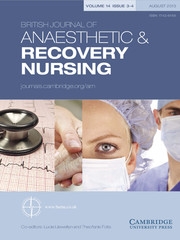This year, BARNA’s Chair Manda Dunne appeared on a video link to Washington, DC for the launch of the World Health Organisation’s (WHO) Safe Surgery Saves Lives campaign. Here she was able to pledge BARNA’s support along with that of other associations around the world for the Safe Surgery Saves Lives initiative. BARNA considers the improvement of surgical safety essential to public health and has endorsed the concept behind the Safe Surgery Saves Lives Checklist. The UK is represented in this worldwide progression by the National Patient Safety Agency (NPSA). This initiative began back in September of 2006 and aims to reduce avoidable complications and death in surgical care. June 26 of this year saw the launch of the Safety Checklist for surgical teams to use in all operating theatres around the world.
Who are the NPSA?
The NPSA is a derivative of the WHO who aim to reduce the risks to surgical patients and improve safety. The NPSA promotes safety by communicating with healthcare associations and organisations using three different approaches, which are set out in their vision statement.
1. Informing: The analysis of reports of patient safety incidents nationally and identifying risks and recommending actions. This includes funding and monitoring of three national independent confidential enquiries.
2. Supporting: The facilitation and encouragement of ethical research in the UK and the promotion of effective local resolution of concerns about the performance of health practitioners.
3. Influencing: The development and implementation of appropriate safety recommendations, advice and strategies as well as the enhancement of public confidence in health and clinical research, with a clear focus on our systems and processes.
What have they found?
In one year alone the NPSA received over 128,000 reports of incidents relating to patient safety in surgical specialties. These incidents were varied, and ranged from misplaced notes to patients receiving surgery on the wrong site. It goes without mentioning that some of these incidents occur regularly and are not always serious, but some have led to severe harm and even death. Leading this challenge is Dr Atul Gawande, who reported that more than 8 million surgical procedures are carried out in the UK per year, which is more than one operation for every eight people. He wants to remind all professionals involved in this that surgery is risky and that safety practices can be inconsistent.
What can be done in the future?
For the last half a century, the aviation industry has been saving lives with the use of the checklist prior to every flight that leaves the ground. This simple initiative to use this technique prior to surgery has been endorsed by a partnership of UK organisations including nurses, surgeons and anaesthetists. The UK is the first country to take on this challenge in its entirety. The lead for the UK is Health Minister, Professor Lord Ara Darzi, who has spoken about how this initiative will improve the understanding and knowledge of the entire surgical team. The Safe Surgery Saves Lives initiative is being piloted at eight sites internationally, with evaluation underway in six of these regions. One of these is St. Mary’s Hospital London, part of Imperial College Healthcare NHS Trust. Preliminary results from a number of these sites have indicated that the Safety Checklist has almost doubled the likelihood that patients will receive increased standards of care in the surgical setting. Using the Safety Checklist in the areas involved in this study have reportedly improved the rate of adherence to standards from 36% to 68%, with some hospitals reporting a 100% improvement. The Safety Checklist has therefore resulted in significant reductions in complications and deaths. Final results on the impact of the Safety Checklist are expected soon.
What does the Safety Checklist entail?
The Safety Checklist is a simple tick box format on one page of A4. It has three columns to be completed; before induction of anaesthesia, before skin incision and before the patient leaves the operating department. It asks the practitioner to confirm vital checks before the patient progresses to the next stage of the operating process. These include ‘Has the site been marked?’ and ‘Is the patient a difficult airway/aspiration risk?’ It is not intended to be comprehensive and additions and modifications to fit local practice are encouraged.
Where can I find out more?
A representative from the NPSA will be speaking at the 2009 BARNA Annual Conference at Devonport House in Greenwich, so keep the 5th of June free. If you would like any further details, please e-mail your contact details to [email protected]. For further information regarding the Safe Surgery Saves Lives initiative and to see a copy of the Surgical Safety Checklist, go to www.npsa.nhs.uk. This site also includes a Safe Surgery Saves Lives training video.
Who is on board?
• Association for Perioperative Practice
• Association of Anaesthetists of Great Britain and Ireland
• British Anaesthetic and Recovery Nurses Association
• British Orthopaedic Association
• College of Operating Department Practitioners; International
• Federation of Gynaecology and Obstetrics
• The Royal College of Anaesthetists
• Royal College of Nursing
• Royal College of Obstetricians and Gynaecologists
• Royal College of Surgeons England
• Royal College of Surgeons Glasgow
• Royal College of Surgeons of Edinburgh.


